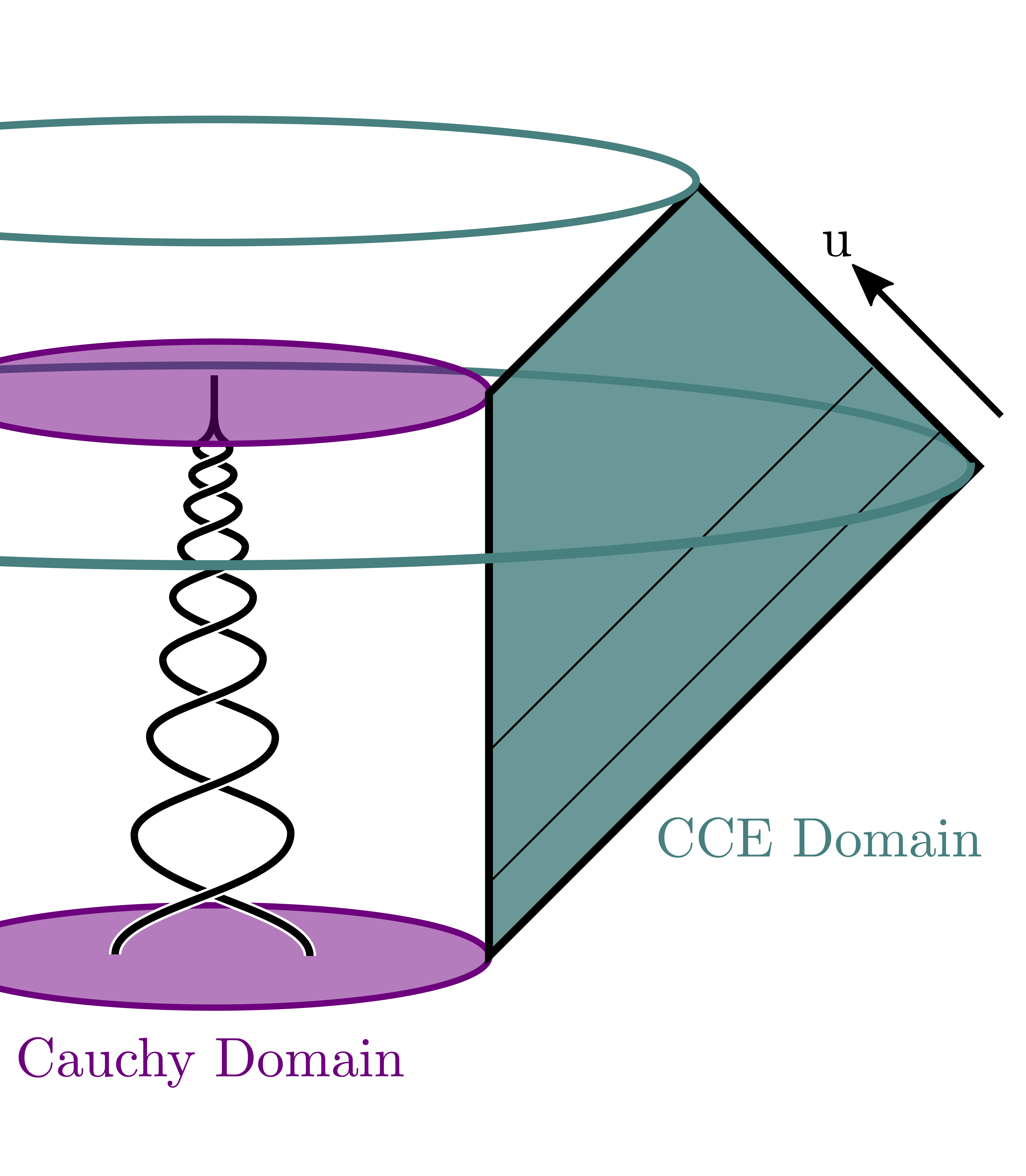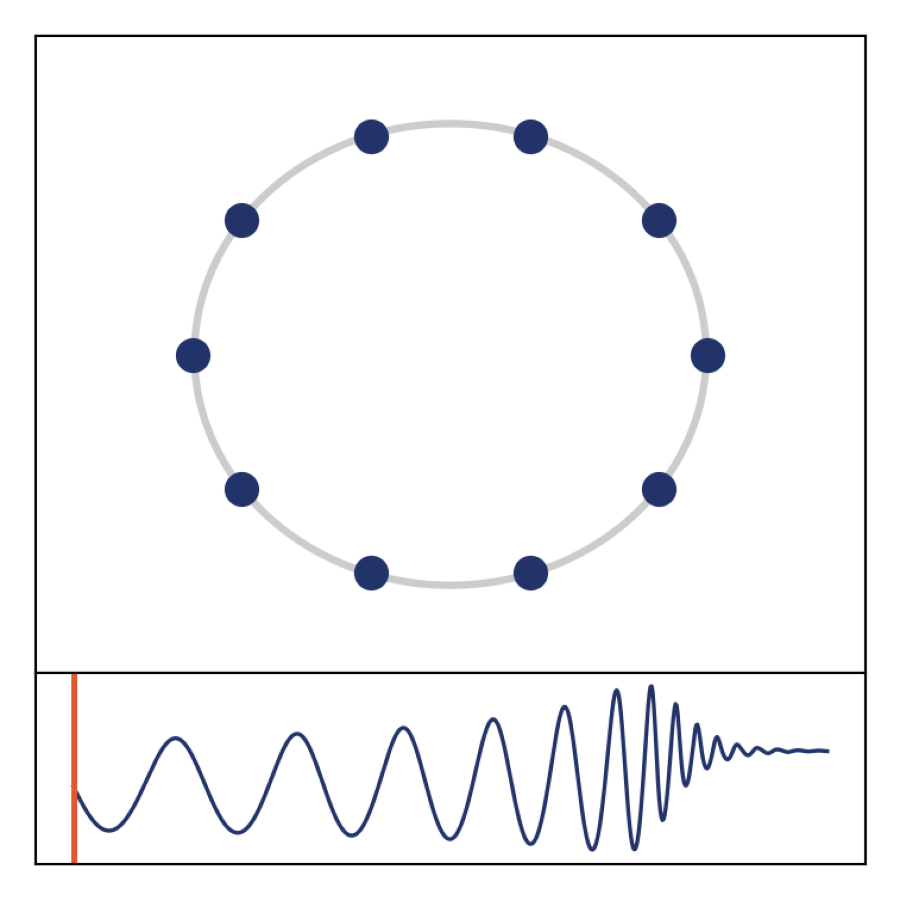# Welcome to my research page!
Below you can find some of the research topics that I’ve worked on in the past, am working on now, or would like to work on in the future! If you have any questions, feel free to reach out!
Contents
- Numerical relativity
- Gravitational wave memory
- Gravitational wave coordinate freedoms: the BMS group
- Gravitational wave hybridizations
- Gravitational wave surrogate models
- Binary black hole ringdowns
- Active galactic nuclei (AGNs)
Numerical relativity
As one may imagine, while solving Einstein’s equations analytically for a single black hole is relatively simple (thanks Roy Kerr!), solving Einstein’s equations analytically for two black holes is effectively impossible and instead one solves them numerically by running a numerical simulation. A priori, however, Einstein’s equations aren’t set up in a form that’s easy to “evolve”. Consequently, to remedy this, we often write Einstein’s equations in what’s called “3+1 form”, i.e., specifying three spatial dimensions and one time dimension, with which we will evolve some space-like initial data. If one works in an appropriate gauge, i.e., a well-behaved coordinate system, then evolving this initial data becomes a well-posed problem (i.e., a solution will exist and be unique).
While this grossly oversimplifies the amount of work required to run a successful numerical relativity simulation, this is the main gist. And at the end of the day, if the code is written correctly, you can obtain some pretty remarkable simulations like this:
In the above simulation, color represents the lapse $\alpha$, which effectively describes how slow time flows due to the spacetime’s curvature. At the bottom there’s also a waveform representing the emitted gravitational wave, which is what we actually observe! But how do we compute that?
Earlier I mentioned that when simulating Einstein’s equations, it’s particularly important to understand and control the coordinate system that you’re using. And this is part of what makes numerical relativity so challenging: there’s an infinite number of coordinates to choose from! This is the general diffeomorphism invariance of general relativity. As a result, we can’t simply provide the LIGO-Virgo-KAGRA Collaboration with the spacetime metric on some worldline in our simulation because it would be highly dependent on the arbitrary coordinate system we chose. Instead, we need a way to limit how much we need to worry about coordinates. One way to do this is to look to some region of spacetime that has some kind of structure that we cannot simply change arbitrary. But where to look? If we assume that the spacetime we’re simulating is asymptotically flat, i.e., that it has zero curvature infinitely far away from the origin, then we’ve naturally focused in on a region of spacetime with structure! While this boundary of spacetime can be partitioned into components, the one we will be interested in is called future null infinity—the final destination of outgoing null (i.e., light-like) radiation such as gravitational waves. Future null infinity, or $\mathcal{I}^{+}$ for short, has a particular structure that restricts what type of coordinate systems are valid. Furthermore, the metric takes on a particularly nice form known as the Bondi-Sachs metric:
\[\begin{align} ds^{2}&=-du^{2}-2dudr+2r^{2}\gamma_{z\bar{z}}dzd\bar{z}\nonumber\\ &\phantom{=.}+\frac{2m_{B}}{r}du^{2}+rC_{zz}dz^{2}+rC_{\bar{z}\bar{z}}d\bar{z}^{2}+D^{z}C_{zz}dudz+D^{\bar{z}}C_{\bar{z}\bar{z}}dud\bar{z}\nonumber\\ &\phantom{=.}+\frac{1}{r}(\frac{4}{3}(N_{z}+u\partial_{z}m_{B})-\frac{1}{4}D_{z}(C_{zz}C^{zz}))dudz+\mathrm{c.c.}+\cdots, \end{align}\]where “c.c.” stands for complex conjugation, $D_{z}$ is the covariant derivative with respect to the round metric on the two-sphere $\gamma_{z\bar{z}}$, $m_{B}$, $C_{zz}$, and $N_{z}$ are functions of $(u,z,\bar{z})$, and ellipsis represent subleading corrections. While “nice” may sound ironic after seeing the equation for the metric, it really is nice because $C_{zz}$ is exactly the gravitational wave that we observe in our gravitational wave detectors! So if we want to compute the gravitational wave in our simulations, then we simply need to solve Einstein’s equations in this Bondi-Sachs gauge.

In practice this works via the following. First, solve Einstein’s equations for a gravitational system in 3+1 form on a series of Cauchy (i.e., space-like) slices, i.e., the blue foliations shown on the right. Then, at some radius, write the metric (and it’s derivatives) to file to produce a “worldtube” of metric data. Once this evolution is finished, one can then proceed to do a second evolution that includes future null infinity on the computational grid by compactifying the radial coordinate, i.e., redifining one’s coordinates so that instead of working with $r\in[r_{\mathrm{worldtube}},\infty]$ one works with finite coordinates, say, $y\equiv1-\frac{2r_{\mathrm{worldtube}}}{r}\in[-1,1]$.

This evolution is called Cauchy-characteristic evolution (CCE), and instead evolves Einstein’s equations on null slices (rather than Cauchy slices). Furthermore, because the radial coordinate is compactified, future null infinity is included on the computational grid so one can easily compute the gravitational wave that current gravitational wave detectors observe! In fact, by performing a Cauchy evolution of a binary black hole coalescence that closely resembles the first gravitational wave detection, GW150914, using the SXS Collaboration’s code $\texttt{SpEC}$ followed by a Cauchy-characteristic evolution executed with the code $\texttt{SpECTRE}$, then one obtains the following solution to Einstein’s equations:

But what’s with the offset at the end? (hint: keep reading to find out)
Image Credit:
- SXS Collaboration, YouTube Channel
- Gourgoulhon, arXiv:gr-qc/0703035
- Moxon et al., arXiv:gr-qc/2110.08635
Gravitational wave memory

Above we saw that unlike what’s commonly presented in the literature, gravitational waves typically do not decay to zero at late times!
This phenomenon is known as the gravitational wave memory effect and corresponds to the fact that two freely-falling observers will experience a net displacement relative to each other due to a gravitational wave passing through the spacetime between them. This is illustrated through the gif shown on the right. While time progresses, the spacetime between the observers (the points) oscillates with the peaks and the troughs of the gravitational wave. But, since the gravitational wave does not decay to zero at late times (due to the memory effect) the observers remain permanently displaced relative to their initial circular configuration! While this effect has yet to be observed, we can resolve it in numerical relativity simulations. And, in the next five-ish years, we expect to be able to claim a detection within the population of events observed by the LVK collaboration.
What makes this effect particularly interesting though, apart from its mind-wrenching nature, is that it turns out to be intimately connected to the symmetries of spacetime and maybe even the tools required for constructing a theory of quantum gravity.
Gravitational wave coordinate freedoms: the BMS group
In developement
Gravitational wave hybridizations
In developement
Gravitational wave surrogate models
In developement
Binary black hole ringdowns
In developement
Active galactic nuclei (AGNs)
In developement
